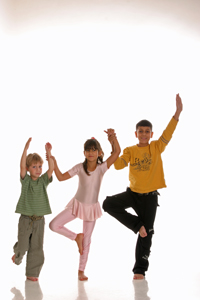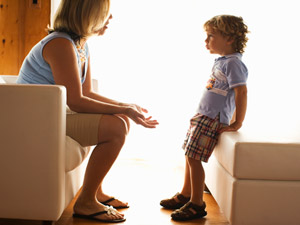
There’s lots of ways to help kids stay in yoga poses longer
The benefits of the Yoga Poses increase as you stay longer in them. But staying for a long time in the poses is not easy for kids simply because, for them, it is totally boring… unless you do some of the following:
Counting
You can count to 10 when you bake a Yoga Pizza (Seated Forward Bend with legs apart), when you go under a yoga tunnel with your imaginary car while in the Yoga Bridge Pose, count down to launching a Yoga Spaceship (Chair Pose with hands raised)… or you can even count really, really slowly when you are in a Yoga Tortoise.
Singing
This is simply the best for younger kids! Try to find a song for every single pose. You can always invent songs on the spot–the kids wouldn’t know if you can’t carry a tune!
Sound effects and animal sounds
It can make the same pose be a totally different animal or object, and it definitely makes everything much more interesting, exciting, and fun!
Balancing animal toys on the head/ back/ arms/ legs/ tummies while in yoga poses
You’ll need to stay still so they won’t fall down!
Telling interesting facts about animals or objects/ cultures/ countries
Sometimes the kids will know more about it than you, and you can all share facts and discuss it – all while you keep holding the pose! Older kids will also be interested to hear about the amazing body they live in.
Saying faster/ higher/ more/ one more / again!
If you are in a Traveling Pose, you can tell the kids “Faster! The _____ (place) is very far! We’ll never get there if we keep going that slow!” In the Sun Dance (Sun Salutation), you can say “One more time, this time double speed!” While doing the Candle Pose (Shoulder Stand) you might want to guide them “Higher! Try to reach the ceiling with your toes!”.
Interaction between the kids
Spice it up! Some kids can be Yoga Tables while the others sit around them in Yoga chairs for dinner. Yoga Flowers and buzzing bees, Yoga Down Dogs and dog owners, Yoga Animals and Zoo Keepers, Yoga Trees and Yoga Monkeys and Yoga Bananas are all great options. Any partner yoga pose or group interaction will help the kids to do the poses for longer. It’s always more fun to do yoga together!
Depending on each other
You can practice relaxation with each kid resting their head on the belly of the person before them (we call it Anaconda Snake Relaxation), or try having some of the kids go under a tunnel made out of Down Dog Poses or crawl under any other pose. If a kid moves out of the pose, they will destroy it for everyone; it’s a great way to learn how interdependent we are.
Using props
You can pass a ball from one to another while staying standing in Yoga Tree or in any other pose, slide a ball down all the Yoga Slides (Incline Plane Pose), hold an umbrella while in the Dancer Pose, wear a crown and hold a wand while in the Yoga Prince or Princess (Chair Pose), put a table cloth (can be a yoga mat) or plastic plates and cups on a Yoga Table, or be covered by a blanket during relaxation… This little flare makes the pose much more engaging!
Petting animals
The kids love it! Go around and pat all the Yoga Dogs or Yoga Bunnies and tell them how cute they are, or that they are a good dog. The kids are sure to stay still in the pose waiting for their turn to be patted.
Taking pictures
You can do it with an imaginary camera, or a real one. The kids need to stay still in the poses for you to take a good picture!
Making it varied and interesting
Lighting all the Yoga Candles and blowing them out, watering Yoga Flowers or Yoga Seeds (Child Pose) that will slowly grow into trees, checking how steady the Yoga Mountains are by gently pushing them to test their stability, fixing Yoga Tables and Chairs, riding Yoga Bicycles upside down in the Shoulder Stand and then continuing to walk and run and surf and snowboard and rollerblade, and skateboard a jump and hop and skip all on the ceiling or sky! …and all while staying in the Shoulder Stand!
Combining poses
Start in Yoga Tree, for example, and then have an eagle in the tree (or a butterfly, owl, or even an elephant) just by changing your hand positions… and all the while staying steady in the Tree Pose! In the same way you can have not just a Warrior 1 and 2 and 3, but also warrior 4 and 5 and even 10… all while you keep holding the same basic pose.
Poses Story
Make up, or let the kids make up, a Yoga Story and have the kids stay in a certain pose until the next Yoga Animal or Yoga Object come up in the story. If the story is interesting enough, it will motivate the kids to stay in the pose. You can even make a rule that the storyteller can only tell his or her story while everyone is in a pose.
Yoga Freeze
With or without music that you pause, freeze for as long as you can in different poses. You can call out names of specific poses, or let the kids choose poses one at a time by calling out their names, or give more general instructions like “Freeze in a pose that will make you stand on one leg” or “Freeze in your favorite pose.”
You can also play the freeze game in a more creative way by turning the kids’ “switches” on and off, or pressing on their “buttons.” When the “switch” is on the kids can move all around the classroom in any way they want, but when you turn them off they have to freeze in a yoga pose. They can’t move until you switch them back on.
Another way to play is to be a Yoga Wizard who turns the kids into Yoga Animals or Yoga Statues where they will be frozen forever! Ha Ha Ha Ha Ha Ha (evil laugh)!
The real point here is that you must make it interesting if you want the kids to stay in the poses…or even do them at all. If your class is boring, the yoga class simply won’t happen. Either the kids will not come to the class, if they have the choice, and there won’t be a class; or they will disturb your class, and you won’t be able to teach. Be smart – be FUN!
Source: http://theyogalunchbox.co.nz/2012/08/14/how-to-help-the-kids-stay-longer-in-poses/















